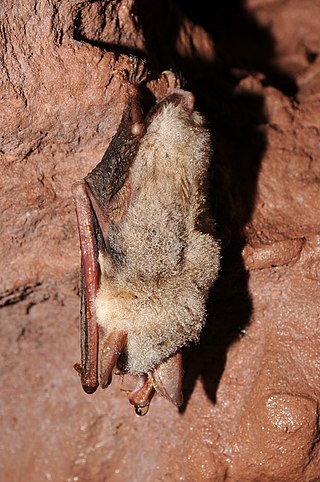
Vespertilionidae is a family of microbats, of the order Chiroptera, flying, insect-eating mammals variously described as the common, vesper, or simple nosed bats. The vespertilionid family is the most diverse and widely distributed of bat families, specialised in many forms to occupy a range of habitats and ecological circumstances, and it is frequently observed or the subject of research. The facial features of the species are often simple, as they mainly rely on vocally emitted echolocation. The tails of the species are enclosed by the lower flight membranes between the legs. Over 300 species are distributed all over the world, on every continent except Antarctica. It owes its name to the genus Vespertilio, which takes its name from a word for bat, vespertilio, derived from the Latin term vesper meaning 'evening'; they are termed "evening bats" and were once referred to as "evening birds".
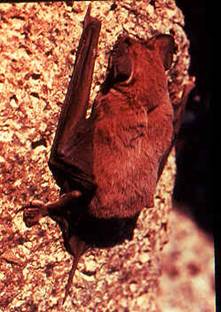
The Molossidae, or free-tailed bats, are a family of bats within the order Chiroptera. The Molossidae is the fourth-largest family of bats, containing about 110 species as of 2012. They are generally quite robust, and consist of many strong-flying forms with relatively long and narrow wings with wrinkled lips shared through their genus. Their strong flying form allows them to fly 60 miles per hour using tail winds and at altitudes over 10,000 feet. This makes them unique among bats, as they are the only bat family that withstands the elevation. They are widespread, being found on every continent except Antarctica. They are typically found in caves, abandoned mines, or tunnels.

The New World leaf-nosed bats (Phyllostomidae) are found from southern North America to South America, specifically from the Southwest United States to northern Argentina. They are ecologically the most varied and diverse family within the order Chiroptera. Most species are insectivorous, but the phyllostomid bats include within their number true predatory species and frugivores. For example, the spectral bat, the largest bat in the Americas, eats vertebrate prey, including small, dove-sized birds. Members of this family have evolved to use food groups such as fruit, nectar, pollen, insects, frogs, other bats, and small vertebrates, and in the case of the vampire bats, even blood.
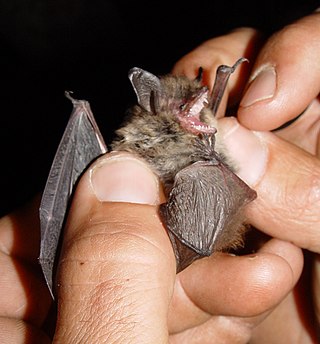
The mouse-eared bats or myotises are a diverse and widespread genus (Myotis) of bats within the family Vespertilionidae. The noun "myotis" itself is a Neo-Latin construction, from the Greek "muós and "oûs", literally translating to "mouse-eared".
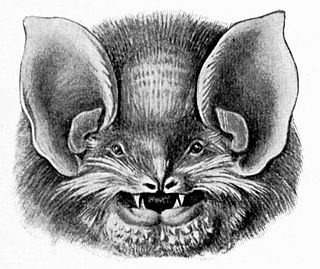
The family Natalidae, or funnel-eared bats, are found from Mexico to Brazil and the Caribbean islands. The family has three genera, Chilonatalus, Natalus and Nyctiellus. They are slender bats with unusually long tails and, as their name suggests, funnel-shaped ears. They are small, at only 3.5 to 5.5 cm in length, with brown, grey, or reddish fur. Like many other bats, they are insectivorous, and roost in caves.

The Mexican funnel-eared bat is a bat species. Despite its name, it is native to the Lesser Antilles in the Caribbean.

The silver-tipped myotis is a species of mouse-eared bat found in a range of lowland habitats in the Americas.

Micronycteris is a genus of leaf-nosed bats.

The Cuban funnel-eared bat is a species of bat in the family Natalidae. It is one of two species within the genus Chilonatalus and is found only in the Caribbean.
The Bahaman funnel-eared bat is a species of bat in the family Natalidae.

Gervais's funnel-eared bat is a species of bat in the family Natalidae. It is the only species within the genus Nyctiellus. It is found in Bahamas and Cuba.

Miniopterus, known as the bent-winged or long winged bats, is the sole genus of the family Miniopteridae. They are small flying insectivorous mammals, micro-bats of the order Chiroptera, with wings over twice the length of the body. The genus had been placed in its own subfamily among the vespertilionid bats, as Miniopterinae, but is now classified as its own family.
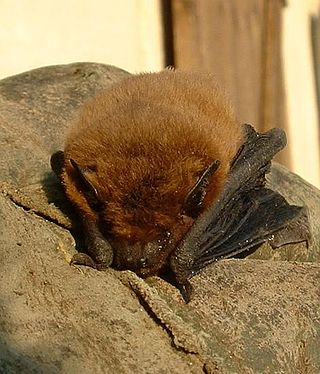
Yangochiroptera, or Vespertilioniformes, is a suborder of Chiroptera that includes most of the microbat families, except the Rhinopomatidae, Rhinolophidae, Hipposideridae, and Megadermatidae. These other families, plus the megabats, are seen as part of another suborder, the Yinpterochiroptera. All bats in Yangochiroptera use laryngeal echolocation(LE), which involves the use of high-frequency sounds to detect prey and avoid obstacles.

Chaerephon is a genus of Old World free-tailed bats in the family Molossidae. Molecular sequence data indicates that Chaerephon, Mops and Tadarida are not monophyletic taxa. The closest relatives of Chaerephon jobimena of Madagascar are Tadarida aegyptiaca of Africa and southwest Asia, and Tadarida brasiliensis of the Americas, which form a clade believed to be about 9.8 million years old. However, the grouping of Chaerephon minus C. jobimena plus Mops was found to be monophyletic.

The Hispaniolan greater funnel-eared bat is a funnel-eared bat species endemic to the island of Hispaniola in the Caribbean. First described in 1902, it has a complex taxonomic history, with some authors identifying multiple subspecies, now recognised as the separate species Natalus primus and Natalus jamaicensis, and others considering Natalus major to be itself a subspecies of Natalus stramineus. It lives primarily in caves and feeds on insects.

The Cuban greater funnel-eared bat is a species of funnel-eared bat. It is endemic to a cave in westernmost Cuba.

The Mexican greater funnel-eared bat is a species of bat found in Central America. While initially and currently described as a species, from 1959 to 2006 it was considered a subspecies of the Mexican funnel-eared bat, Natalus stramineus.
Nancy B. Simmons is an American zoologist, mammalogist, professor, and author. Specializing in bats, Simmons has conducted extensive research on the morphology and evolutionary history of numerous bat species. She is also the curator-in-charge of the Department of Mammalogy at the American Museum of Natural History and a professor at the Richard Gilder Graduate School.
Chilonatalus macer is a species of bat endemic to Cuba.
















